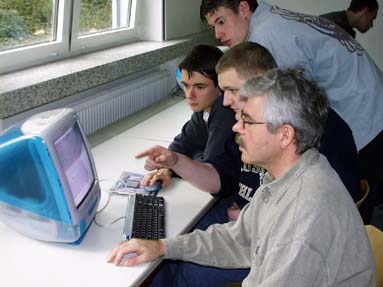JAVA,
SUN MICROSYSTEMS FLAGship programming language, has a
favored status on the Internet because it is easy to learn,
versatile, and "portable" _ that is, programs can
run on various systems. With several computer hardware
platforms and operating systems vying for market share,
programmers wishing to write software that can be used by
just about everyone have seen the obvious benefits of Java.
These features have made it popular among those developing
software for the World Wide Web.
Most
Web surfers will have encountered "applets" _
small Java-based routines embedded within Web pages
_ often without realizing it (unless you notice
when your Web browser pauses and the message "Starting Java"
appears in a corner). These programs usually require no more
than a recent browser to run. Applets bring interactivity to
a Web page by combining text, graphics, animation, and
sound, greatly enriching the online experience by overcoming
the limited graphical capabilities of HTML. Users can access
an applet with a wide variety of computer architectures and
Internet browsers, assured of seeing information in
essentially identical formats whether they're using Windows,
MacOS, or Unix/Linux.
Java
is relatively new and still evolving, so it lacks some
features that are present in established languages such as C
or Pascal. Its limited native support for complex arithmetic
means many algorithms have to be written from the ground up
for math-intensive functions. However, this hasn't stopped
many people from generating Web-based software for
scientific purposes. One of the most prolific writers of
Java applets for astronomical use is Juergen Giesen, a
56-year old high-school teacher from Welver, Germany. His
Web site (www.jgiesen.
de/GeoAstro/GeoAstro.htm) delivers

German high-school teacher Juergen Giesen (foreground) discusses the finer points of Java programming with his students. He is the author of an online astronomical Java applet collection. Courtesy Juergen Giesen.
a
veritable cornucopia of original software of astronomical
interest.
Giesen's
computing career dates back to 1965, when he programmed a
Zuse Z23 in ALGOL. Subsequent work with FORTRAN on IBM and
UNIVAC machines led to a thesis on the physics of metals in
1975. He started teaching highschool mathematics and physics
two years later. An encounter with an Apple II in the late
1980s instilled a passion for later Macintosh personal
computers that persists to this day; that, and a desire to
program in Pascal.
Realizing
that the Macintosh platform and being a practitioner of
Pascal placed him in a small but select group, Giesen
started working with Java in a bid to extend the audience of
his work. Now his prolific efforts in the field of Java
applets have won him much more praise and recognition than
from just his students.
The
wide-ranging appeal of his positional astronomical
calculations concerning the Sun, Moon, and beyond have
garnered attention from all over the world.
A
prerequisite for perusing this applet site is a Java-enabled
browser such as Microsoft Internet Explorer 4, Netscape
Navigator 4, iCab 2.4, or others. Even so, do ensure that
Java is enabled in your software's preferences before
visiting the site. The visitor can choose English or German
versions of each page, which offer copious links to Giesen's
other astronomical interests and those relating to
physics.
The
complete set of applets may be previewed on the home page as
GIF images showing typical output, or the applets themselves
may be run online. Users can download a demo version of each
applet or purchase a registered version for use offline. The
complete GeoAstro Collection
58 June 2001 | Sky & Telescope